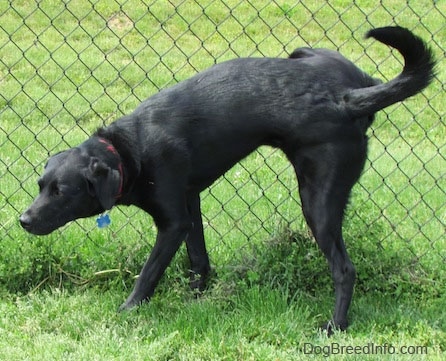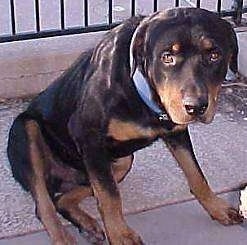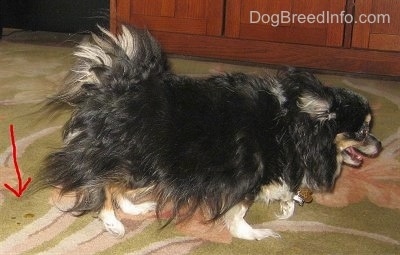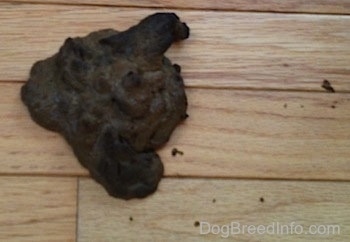
Housebreaking your new puppy is going to take patience. You should begin to housebreak as soon as you bring your new puppy home. Puppies need to relieve themselves approximately six times a day. A puppy should be taken out immediately after each meal since a full stomach puts pressure on the colon and bladder.
After about 8, 9, 10 weeks of age, or when the puppy arrives at it's new home, the dog should be taught to go potty outside. Do not have paper or potty pads inside your home. Peeing is for outside only, or you are teaching your new pup it is okay to potty inside your home.
Take advantage of any early training the breeder hopefully has already done. Teach your pup to potty on a designated spot outdoors, making him think.
After you bring home your new puppy the first thing you need to teach the pup is to walk to the door. Do not carry it. Make the puppy walk or it will not learn to alert you.

Do not use treats when potty training as it takes the dog's focus off of the business at hand and puts it on the food. You do not want the dog's brain to be on food when it is time to relieve itself.

This often causes a dog to not completely finish eliminating because the dog is looking and waiting for food. The dog will often come back inside the home and go to the bathroom again after just being out. Keep the focus on the task at hand. Rewards for pottying should be the relief the dog feels when it empties itself, your happiness that the dog did the right thing, along with verbal praise, a pet and/or back scratch. Dogs can feel when the humans are happy.
Do NOT use the Misty Method for older puppies. This method is only for pups 3 to 8 weeks of age who have not yet left the breeder.
A puppy is not physically able to control the muscle that allows him to "hold it" until he is about 12 weeks of age. Before this time, good housebreaking routines should be practiced to avoid having your puppy urinate and defecate all over your house. Watch for signs of urination or defecation, such as turning in circles. Take your puppy out often. Using a crate or confining your puppy to a small part of the house that has easy clean up floors are some ways to ensure your puppy does not urinate all over your house. It is much harder to housebreak a puppy if he smells is urine in places you do not wish him to relief himself.
Lena the Border Collie mix being a "good dog"
A dog who goes on daily pack walks is less likely to soil in the home out of anxiety.

There are many different methods in which you can housebreak your pet. Whichever way you choose, it is important to understand your puppy. Dogs want to please; the trick is to make them understand what it is you want from them.
Dogs do not think the way humans do. When you are unhappy with your dog, it assumes that whatever it is doing at the exact moment you show disapproval is the thing that is upsetting you. For example, if your puppy relieves himself on your floor and you show your disapproval five minutes after he has committed the act, the puppy will think that the mess on the floor is bad. He will not relate the fact that it was the act of relieving himself on your floor that you disapprove of. The dog will eliminate, see the mess and get worried; you are now going to be unhappy. This is the reason so many dogs will relieve themselves in inappropriate places and look really guilty about it, yet they continue to do it. Dogs want to please, right?

Some owners start to think that their dog is being sneaky when really it does not fully understand what it is doing wrong. It knows the mess upsets you but does not understand that it should stop "making" the mess. To your dog, these two things: "the mess" and "the act" are unrelated. The trick is to catch your dog in the act and make him understand. You should not hit your dog. Your tone of your voice is enough to make the dog see you are unhappy. A firm "No! You are not allowed to go in the house. No! No!" is all that is needed. Immediately take your dog outside to the appropriate place. Wait for your dog to go again and when and if he does, praise him.
For more on understanding dog behavior read the articles on this page: Dog Behavior Articles

Pookie, the 4-pound longhaired Chihuahua CAUGHT peeing on the carpet! Pookie squatted and peed just a few drops. In a matter of seconds the pee soaked into the carpet. Had no one been looking at that exact moment the incident would have gone unnoticed.
Before you crate-train, please be aware: a dog that is left in a crate all day long, gets let out in the evening after work for a few hours and put back in the crate for the night can become neurotic, destructive, unhappy and noisy. If you work all day, it is recommended that you find someone who can take your dog out for a long walk in the afternoon. Dogs are not fish. They need something to occupy their minds. Dogs are den animals and like the crate, but even a den animal would go crazy if it was locked up all day long. Keep in mind that a puppy can only physically hold it for so long before its body just cannot hold it any longer. Until the pup's bladder is fully mature it will need to be taken out often.
You must be willing to invest time and energy for just a few short weeks in housetraining. The effort you put in now will last for the rest of your pet's life.
The crate training method is as follows. Buy a crate and for the first three to four weeks keep your puppy in it when you are not with him. Make sure the crate is not too big. It should be large enough for the puppy to stand up and easily turn around but no larger. Dogs do not want to soil their beds and the use of a crate teaches them to control their urge to eliminate. You must maintain an eagle-eye at all times. As soon as you see him pacing, sniffing around, and turning in circles, immediately take him outside. He is telling you "I am going to go pee-pee somewhere, and this carpet looks like as good a place as any." NO, you do not have time to put on your shoes, just go.
Be patient and do not rush the little guy. He may have to go several times in one "pit stop." Give him about 10 minutes before taking him back inside. Do not play with him while you are on this mission. Let him know this is a business trip.
Make sure you take him out after every meal and play session BEFORE you put him back in his crate. Be consistent and establish a schedule. Pay attention to your puppy's behavior so you can develop a schedule that works for you and the pup. When does your puppy naturally defecate? In the morning? Ten minutes after eating? Around bedtime? You may have to make some compromises.
Be fair to your puppy. He cannot be expected to stay alone in his crate for endless hours and not relieve himself. During your work days, you will need to have someone go to your home at least once (lunchtime is good) to let the puppy out and take him for a long walk. Your dog is not a fish and he needs something to occupy his mind.
Make sure everyone who is involved in the housebreaking process is using the same spot in the yard and the same word. Everyone should agree on the place they will take the puppy. The odor from the previous visits will cause the puppy to want to go in that spot. Use a simple word like "outside" when taking your puppy to the chosen spot. Use this word consistently and later this word will help build communication between the family and the dog. When you notice him going toward the door and you say "outside" he can say, "Yup, that’s where I need to go."
Until your puppy is about 5 months old you will need to take him out frequently and keep that eagle-eye on him. But before you know it, you are going to be able to trust and communicate with your new pet. And he will learn that when he pleases you by going out to do his business, he gets more freedom in the house.
Belly Bands for Male Dogs: (Courtesy of Misty Trails Havanese)
Belly bands are a GREAT training tool for male dogs to keep them from marking (lifting their leg on your furniture). Put them on while they are in the house, and take them off when outside. Also if a dam is in heat, it helps to stop the marking.
A cloth belly band wrapped around the stomach of a dog.
If your puppy is a breed that stays small and it is going to be an indoor pet, you may want to try paper training if you do not mind the smell. Place layered newspaper in the corner away from the feeding and water dishes. After meals take the puppy to the newspaper. Each time the puppy eliminates, change the top layer of newspaper and leave the bottom layer. Puppies like to go where they smell urine and feces and will start to prefer the newspaper over any other spot.

Remain consistent. Do not allow your puppy to do something one day and not the next. This will confuse him. Never leave an untrained puppy unattended in the house. Make your dog understand what is expected of him. Dogs want to please. Always praise your dog for good behavior. No form of physical punishment is as effective as praise and encouragement.
Note: Puppies that were bred by a breeder that uses the Misty Method way of whelping puppies have an easier time catching on to the concept of housebreaking. This method was started by Bev Dorma of MistyTrails Havanese/Mastiffs. Breeders who have adopted this way of whelping their puppies have reported a very high success rate.
Written by Sharon Rose and Dawn Littlefield© Dog Breed Info Center® All Rights Reserved
